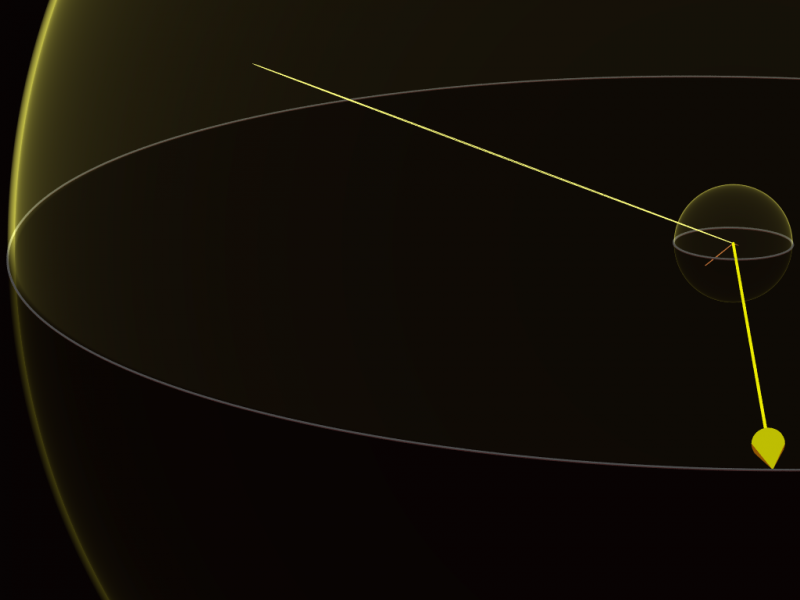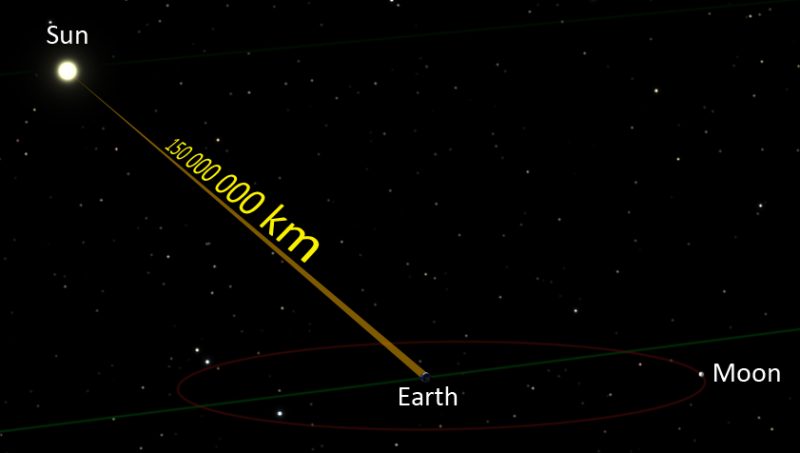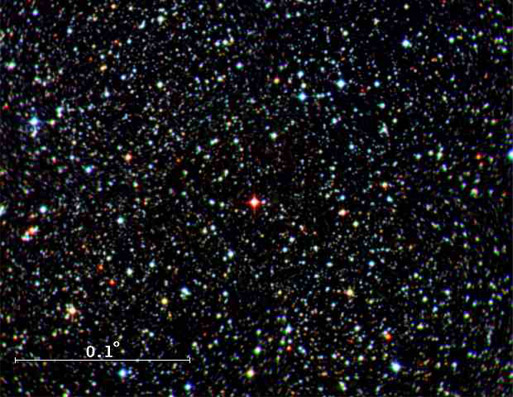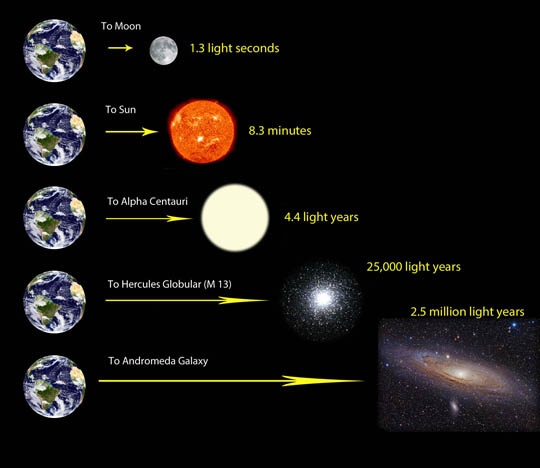4.2 Light Years To Km

Objects in our universe are extremely far abroad. They're so far away that kilometers or miles aren't a useful measure of their distance. And so we speak of infinite objects in terms of calorie-free-years, the distance light travels in a year. Light is the fastest-moving stuff in our universe. Information technology travels at 186,000 miles per second (300,000 km/sec). And thus a light-year is 5.88 trillion miles (9.46 trillion kilometers).
But stars and nebulae – not to mention distant galaxies – are vastly farther than ane light-yr away. And, if we try to express a star's distance in miles or kilometers, we shortly end up with impossibly huge numbers. Yet miles and kilometers are what almost of us use to comprehend the distance from i identify on Earth to another. In the late 20th century astronomer Robert Burnham, Jr. – author of Burnham's Celestial Handbook – devised an ingenious way to portray the distance of light-years in terms of miles and kilometers.
Keep reading, for a fashion to comprehend the vastness of the universe, using units of altitude nosotros know and utilize every solar day.
Burnham started by relating the light-year to the astronomical unit – the Earth-sun altitude.
I astronomical unit of measurement, or AU, equals about 93 million miles (150 one thousand thousand km).
Another mode of looking at it: the astronomical unit is a bit more than than 8 light-minutes in altitude.

A light-twelvemonth, pictured as a mile
Robert Burnham noticed that, quite by coincidence, the number of astronomical units in one light-yr and the number of inches in one mile are virtually the same.
For general reference, there are 63,000 astronomical units in i low-cal-yr, and 63,360 inches (160,000 cm) in ane mile (1.6 km).
This wonderful coincidence enables us to bring the lite-year downward to Globe. If we scale the astronomical unit – the World-sunday distance – at one inch, then the lite-year on this calibration represents 1 mile (one.vi km).
The closest star to World, other than the sun, is Alpha Centauri at some 4.4 lite-years away. Scaling the Globe-dominicus distance at one inch places this star at 4.iv miles (7 km) afar.
Come across?

Familiar space objects, conceptualized
Scaling the astronomical unit at one inch (2.5 cm), here are distances to various bright stars, star clusters and galaxies:
Alpha Centauri: 4.iv miles (6.4 km)
Sirius: 8.6 miles (xiv km)
Vega: 25 miles (xl km)
Pleiades open up star cluster: 444 miles (715 km)
Antares: 555 miles (893 km)
Hercules globular star cluster (aka M13): 22,200 miles (35,700 km)
Center of our Galaxy galaxy: 26,100 miles (42,000 km)
Cracking Andromeda galaxy (M31): 2,540,000 miles (4,100,000 km)
Sombrero galaxy (M104): 28,000,000 miles (45,000,000 km)
Whirlpool galaxy (M51): 31,000,000 miles (50,000,000 km)
And so on, dorsum to approximately 13 billion+ light-years to the farthest galaxies: xiii,000,000,000 miles (21,000,000,000 km)
Okay, the numbers are withal pretty large! Just hopefully they tin help you see that our universe is very vast.

The fastest-moving stuff in the universe
As mentioned above, light travels at an incredible 186,000 miles per 2d (300,000 km/sec). That's very fast. If you could travel at the speed of lite, yous would be able to circumvolve the Earth's equator well-nigh vii.v times in simply one second!
In other words, a light-second is the distance light travels in one second, or vii.5 times the distance around Earth'south equator. A lite-year is the distance light travels in 1 year.
How far is that? Multiply the number of seconds in ane year by the number of miles or kilometers that low-cal travels in ane second, and in that location you accept it: ane light-twelvemonth. It's near v.9 trillion miles (9.5 trillion km).

Bottom line: Here's a way to understand the calibration of light-years in miles and kilometers.
Read some other article answering the same question: What is a lite-twelvemonth?
Enjoying EarthSky? Sign up for our gratis daily newsletter today!
4.2 Light Years To Km,
Source: https://earthsky.org/astronomy-essentials/how-far-is-a-light-year/
Posted by: gonzalezcommens.blogspot.com


0 Response to "4.2 Light Years To Km"
Post a Comment